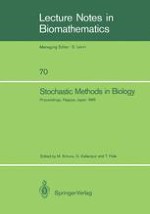The use of probabilistic methods in the biological sciences has been so well established by now that mathematical biology is regarded by many as a distinct dis cipline with its own repertoire of techniques. The purpose of the Workshop on sto chastic methods in biology held at Nagoya University during the week of July 8-12, 1985, was to enable biologists and probabilists from Japan and the U. S. to discuss the latest developments in their respective fields and to exchange ideas on the ap plicability of the more recent developments in stochastic process theory to problems in biology. Eighteen papers were presented at the Workshop and have been grouped under the following headings: I. Population genetics (five papers) II. Measure valued diffusion processes related to population genetics (three papers) III. Neurophysiology (two papers) IV. Fluctuation in living cells (two papers) V. Mathematical methods related to other problems in biology, epidemiology, population dynamics, etc. (six papers) An important feature of the Workshop and one of the reasons for organizing it has been the fact that the theory of stochastic differential equations (SDE's) has found a rich source of new problems in the fields of population genetics and neuro biology. This is especially so for the relatively new and growing area of infinite dimensional, i. e. , measure-valued or distribution-valued SDE's. The papers in II and III and some of the papers in the remaining categories represent these areas.
